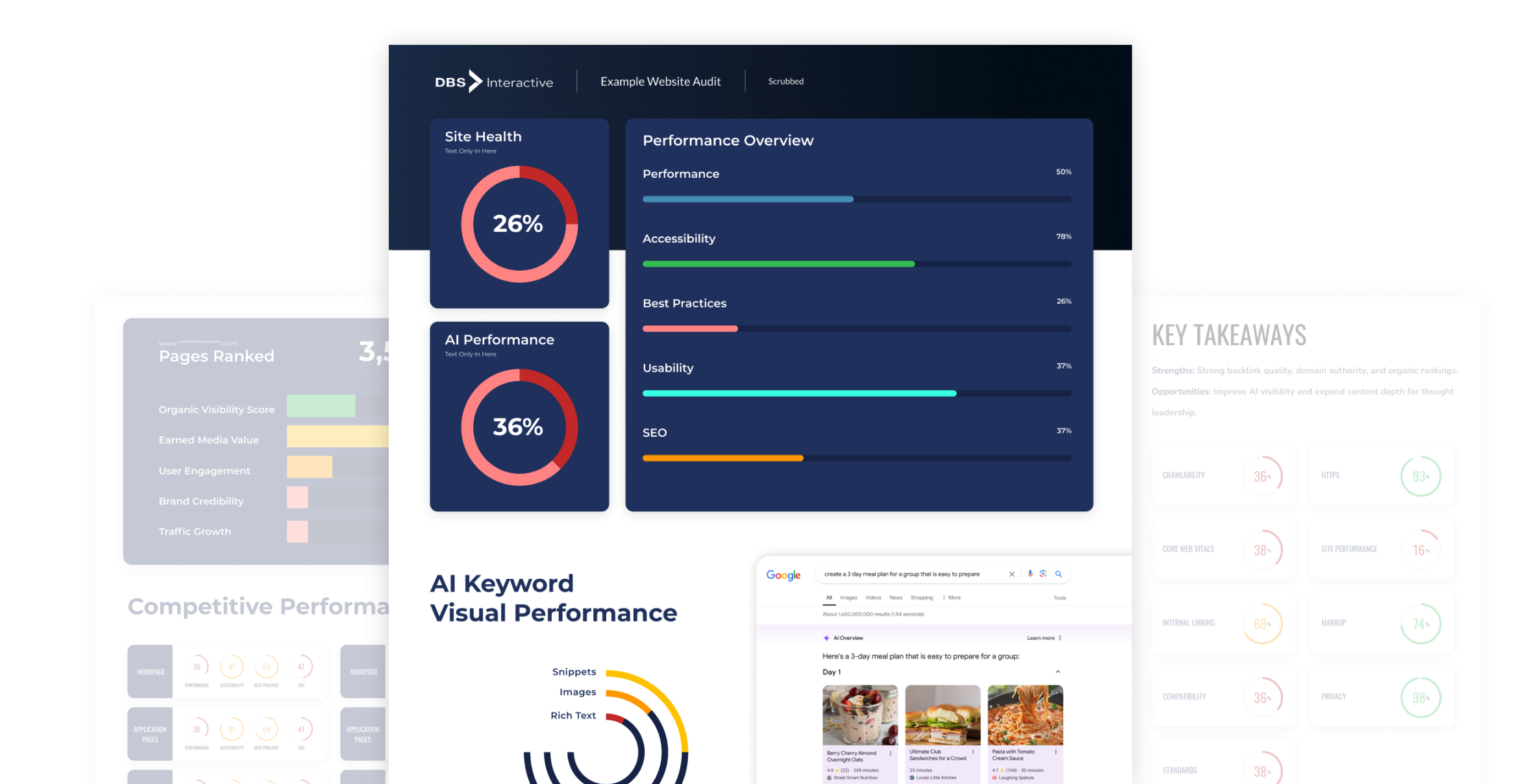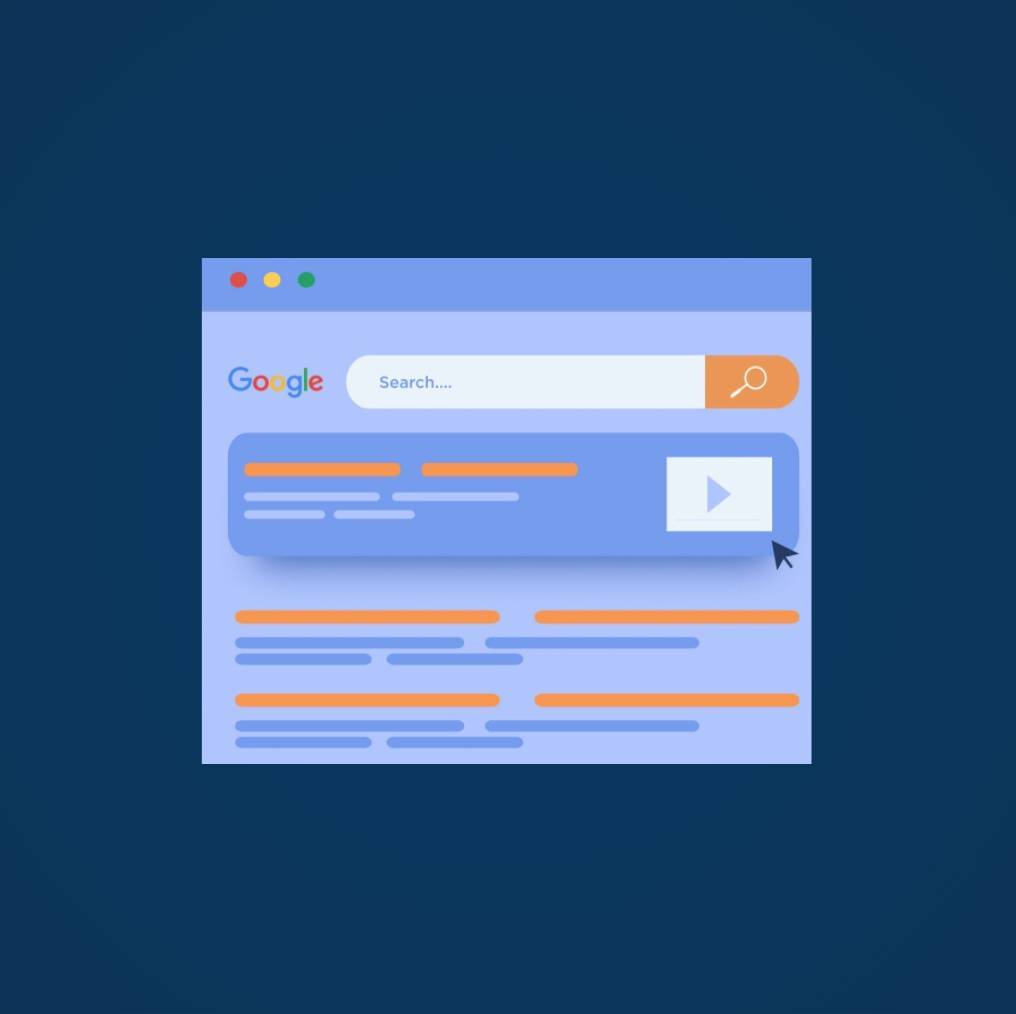

AI Overviews vs. Featured Snippets in Google
Google’s Featured Snippets of organic search results look and function differently than its generative AI Overviews. Here’s what to know.
Search marketing is evolving rapidly. Google’s search results page (SERP) is no longer just a list of “10 blue links.” New result types from Featured Snippets to AI Overviews are changing how users find information. Business and marketing leaders, especially in manufacturing, B2B, and healthcare, need to understand these features to stay visible.
This article explores Google’s AI Overviews and Featured Snippets, covering their differences, similarities, and business value. We’ll also compare them side by side, discuss areas of overlap, and outline strategies to help your business adapt.
Understanding a New Era of Google Search Results
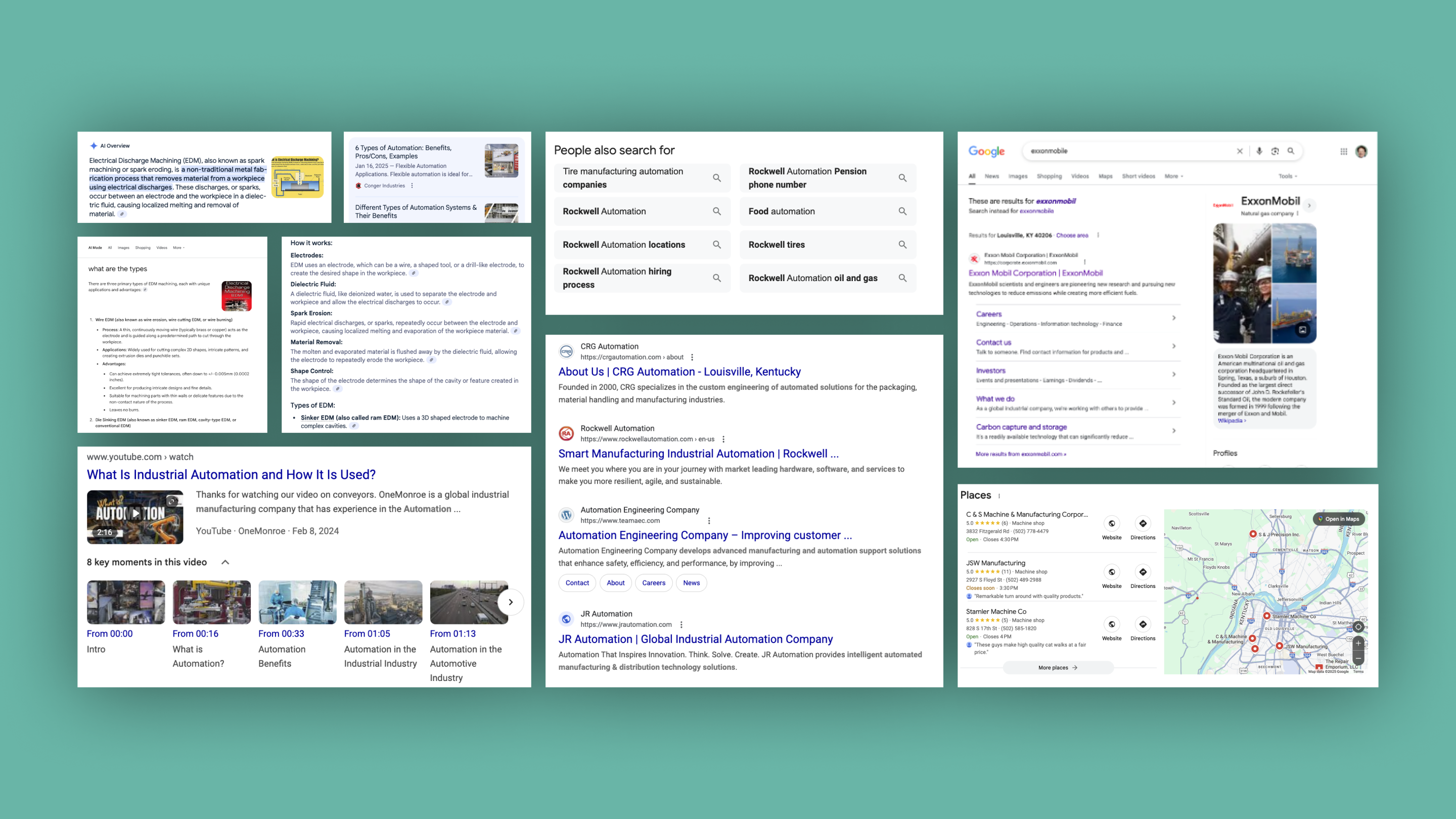
The rules of search marketing are shifting. Google is continually introducing new SERP features that provide instant answers or rich information without requiring a click. These include Featured Snippets, AI Overviews, local packs, Knowledge Panels, People Also Ask questions, rich snippets, and more. The prominence of these elements means that ranking “number one” organically might not guarantee the top spot on the page anymore.
Users can often get answers at a glance, which is transforming user behavior. For businesses in sectors like industrial manufacturing, B2B tech, or healthcare, it’s crucial to recognize that your target audience may see an answer from Google before they ever see your website. In this context, understanding AI Overviews and Featured Snippets – two of the most impactful quick-answer features – is essential for maintaining and growing your search visibility.
Featured Snippets: The Original “Position Zero”

Introduced by Google in 2014, featured snippets have become a key element in how people discover quick answers online. These search results are designed to provide users with concise, direct responses to their queries, sometimes appearing at the top of Google’s results page.
Definition & Purpose
Featured Snippets are highlighted search results that Google places at the very top of the organic results, often referred to as “Position 0.” Snippets provide a concise, direct answer to the user’s query on the results page. Google’s systems identify a segment of content from a relevant webpage – a snippet of text, and sometimes an image – and display it in a special box above the usual results.
As designed, snippets save users' time by answering questions immediately. Featured Snippets typically appear for queries phrased as questions or definitions (e.g., “What is X?”, “How to do Y?”), where a quick answer is helpful.
Formats & Examples
- Paragraph snippets- a brief text excerpt, often a definition or description.
- List snippets- bulleted or numbered steps, useful for “how-to” queries or top-10 lists.
- Table snippets- for comparisons or data.
- Video snippets for certain queries.
For example, searching for “How to boil an egg” might return a paragraph snippet with step-by-step instructions, while “Top 5 manufacturing automation tools” could trigger a numbered list snippet.
No matter the format, the snippet box includes a link to the source website so that users can click through for more details. Thanks to Google's scroll-to-text highlighting, clicking the snippet often takes the user directly to the relevant section of your page.
Placement
Just like the housing market, location is everything.
Featured Snippets occupy prime real estate – they show up above the regular organic results, often right above or below any PPC-sponsored links.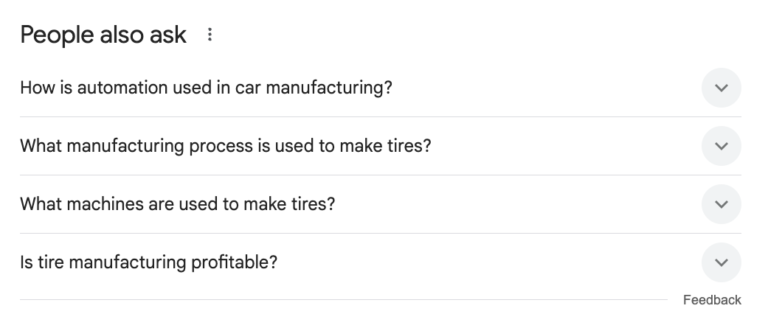
This prominence makes them highly visible. They effectively steal some of the limelight from the #1 organic listing. It’s not uncommon, for instance, to see a Featured Snippet at the top and the first traditional result begin further down the page.
In many cases, Featured Snippets also appear within the “People Also Ask” section for related questions, providing quick answers.
Why They Matter
Earning a Featured Snippet can be a golden opportunity for a business.
It boosts brand visibility and credibility. Users often assume the featured answer is authoritative.
This “halo effect” means that appearing as a snippet can enhance your authority in the eyes of potential customers.
Moreover, Featured Snippets can drive meaningful traffic – emphasis on meaningful. Studies have found that the Featured Snippet gets around 8% of all clicks on the search page. That’s potentially extra traffic on top of whatever your normal ranking would have earned.
In B2B and manufacturing sectors, where buyers research detailed questions, being the featured answer can put your company front and center as a trusted resource. It’s effectively free advertising in the search results.
That said, snippets are a double-edged sword.
Because the answer is displayed upfront, some users might get their answer and not click through to your site. This is the zero-click search phenomenon.
If the snippet fully answers the query, like a simple definition, the searcher may not need to visit your page. On the other hand, if the query is complex, the snippet can pique interest and increase clicks from users seeking more depth.
A Featured Snippet gets around 8% of all clicks on the search page.
For example, a snippet answering “What is a CNC machine?” might satisfy a casual query, but a snippet for “How to implement lean manufacturing” will likely lead interested readers to click for the full details.
Users who click through a featured snippet may have greater business intent than those looking for a simple answer.
Overall, Featured Snippets are valuable for brand exposure and can drive traffic for higher-intent queries. If you don’t occupy that spot, a competitor or third party will. In sectors like healthcare, snippets often pull from reputable and authoritative sites. Healthcare businesses should aim to produce accurate, high-quality content if they want to be featured.
How to Earn Featured Snippets

There’s no special markup or payment to get a snippet. Google’s algorithm decides if a page provides a great answer and elevates that information. However, content strategy can improve your chances.
Many B2B and industrial companies succeed by identifying common customer questions and crafting clear, concise answers on their site, for example, a blog post that directly and concisely answers “What are the benefits of robotic automation in manufacturing?”.
Structured content with headings that ask the question and a succinct paragraph or list that answers it can help. In fact, Google often pulls snippet text from content that is formatted as a Q&A or a definition.
Also, you typically need to be in the top 5-10 results to be considered for a snippet. This means general SEO best practices still apply. We’ll discuss specific tactics in the strategy section, but remember: Featured Snippets reward direct answers and clarity.
Google’s AI Overviews
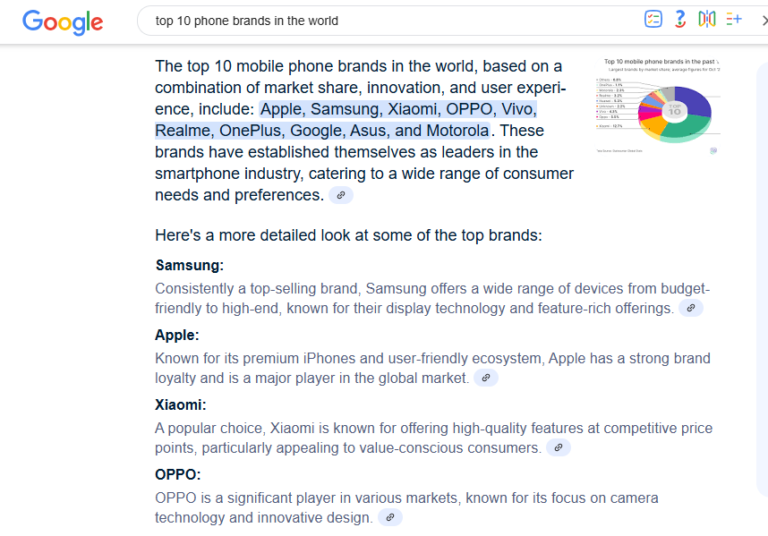 AI Overviews are Google’s newest way of answering queries. These are the AI-generated summary answers you may have seen in search results.
AI Overviews are Google’s newest way of answering queries. These are the AI-generated summary answers you may have seen in search results.
Initially introduced as part of Google’s experimental Search Generative Experience (SGE), AI Overviews (AIOs) are now rolling out more broadly, sometimes referred to as “super-snippets”.
An AI Overview is an AI-generated snapshot at the top of the results page that synthesizes information from multiple sources to give you a quick overview of a topic.
For example, if you search a complex question like “best materials for 3D printing medical devices,” Google’s AI might produce a few paragraphs comparing materials, citing various websites, all within a colored box at the top of the SERP. The purpose is similar to a featured snippet. It provides immediate help using advanced generative AI methods that aggregate and summarize many internet sources.
How It Works & Appearance
An AI Overview typically appears at the top of the first search engine results page (SERP) with a subtle shaded background and the label “AI overviews are experimental” (as of this writing).
It often contains a brief textual summary addressing your query, and it may include key points, bullet lists, or even images. Importantly, the overview features a link icon at the bottom right of text blocks that redirects to the sources the AI system accessed. Often, after the initial answer, Google provides follow-up questions or the ability to continue the conversation, a bit like a built-in chatbot for search.
This interactive element allows users to refine their query, ask a related question, and get another AI-generated response, without leaving the SERP. Essentially, AI Overviews turn Google Search into a more conversational, research-oriented tool. Users can get a multi-faceted answer and then dig deeper by either clicking the cited links or asking a follow-up in the AI interface.
When & Why AIOs Appear
Google doesn’t generate an AI Overview for every query. It shows up “when our systems determine that generative responses can be especially helpful,” the company says.
In practice, AIOs appear for broader or complex questions where a quick compiled overview saves the user from doing multiple searches. For instance, a query like "benefits and risks of telemedicine in rural areas" might trigger an AI Overview summarizing key points in healthcare. For very sensitive medical queries or YMYL (Your Money or Your Life) topics, Google might be cautious and not generate AI answers or default to standard results.
In manufacturing and B2B, queries such as “compare CNC vs 3D printing for prototyping” or “how to improve supply chain efficiency” could prompt AI Overviews, since the user is looking for a nuanced answer that might come from different sources, such as case studies, expert articles, etc.
In fact, an industry study found that longer, information-seeking queries of around five words, often including terms like “how,” “tips,” “manage,” and “best,” are more likely to trigger AI Overviews. These long-tail keyword phrases are the kind of exploratory questions common in B2B and industrial research, as well as high-level healthcare queries.
Google’s stated goal is to help users “quickly understand information from a range of sources” via AI Overviews.
Rather than clicking through multiple pages to piece together an answer, the AI does that work for you. From a user perspective, it’s like getting a mini-report. From a business perspective, this raises the stakes for content quality. Google's AI will only be as good as the content it can find, which means users must validate and verify information.
The strategy section highlights how to get your content included in these overviews.
Differences from Featured Snippets
At first glance, an AI Overview looks somewhat like a mega-featured snippet, but there are key differences.
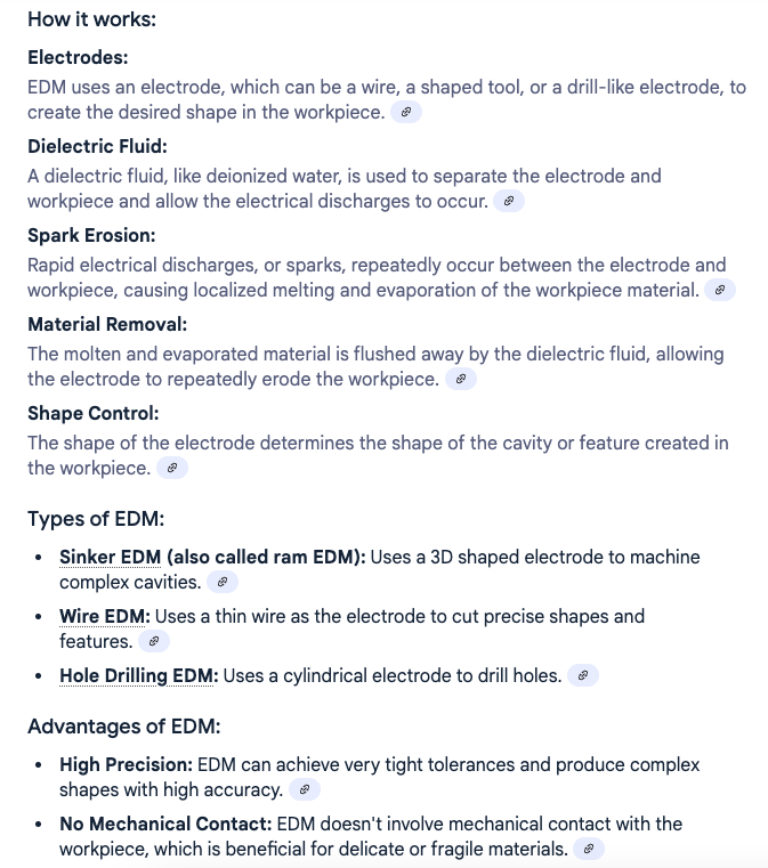
- Sources: AIOs aggregate multiple sources. The AI might use information from several different websites to construct its answer. Featured Snippets, on the other hand, directly quote a single page. For example, if five different sites have part of the answer to “how to reduce machine downtime,” the AI Overview might weave together a summary citing all five. A featured snippet would typically take one site’s paragraph on the topic.
- Content & Tone: AIO content is generated by Google’s AI, so it’s written in a synthesized way. It might combine facts, ensure a neutral tone, and omit fluff. Featured Snippet text is exactly as written by the source page, often including that page’s tone or phrasing, truncated for brevity. AIO text can sometimes read more uniformly, whereas snippet text might feel more human, since it is human-written content extracted from a page.
- Interactivity: Featured Snippets are static – they show an answer, and that’s that. AI Overviews are interactive. Users can click follow-up questions or type a new question to get more AI-generated info. This is part of the conversational mode of SGE/AIO. In other words, AIOs invite the user to dig deeper within the Google interface. This interactivity is a significant change: with Featured Snippets, if users wanted more, they’d click through to a website or manually refine their search. With AIO, Google aims to handle the follow-ups itself.
- Format & Length: AIO responses are longer than most featured snippets. According to one study, the average AI Overview is about 169 words and occupies considerable real estate. Featured Snippets are usually much shorter, often 40-60 words for a paragraph snippet. Additionally, AI Overviews can include lists, images, or even small data tables as part of the answer. They often feature an “expand more” button to show the complete response. A Featured Snippet might include an image, but it’s typically one image and a brief text excerpt.
- Placement on SERP: Currently, AI Overviews appear at the very top of the results page, even above Featured Snippets if both are present. If an AI Overview is shown, it pushes everything else down. In Google’s experimental phase, sometimes the AI box appeared below the ads and snippet, but as of the latest updates, AIOs are generally the first thing you see. In effect, AIOs have become the new “position 0,” and the traditional Featured Snippet might be slightly below it.
Business Value & Impact
For businesses, AI Overviews represent the new frontier. On the one hand, they offer another way for your content to gain visibility.
If the AI uses and cites your website's information, you could appear as one or more of a few highlighted sources in the overview, exposing your brand to users who wouldn’t have clicked through multiple links themselves. Interestingly, Google reported that during the SGE experiment, people “used Search more, were more satisfied,” and that links within AI Overviews got more clicks than if those pages were just regular results.
"A click from an AI Overview isn't casual. It's deliberate." -- Steve Fowler, Marketing Director, DBS Interactive
As one of the cited sources, an AI answer could drive more traffic to you than a typical organic result, since AI elevates those sources and makes them more enticing to click. That’s a significant upside.
On the other hand, AI Overviews could also diminish overall organic traffic for specific queries. If the AI answer fully satisfies the user, they might not click any results, similar to the zero-click issue with snippets, but potentially more pronounced.
While some SEO experts predict “fewer reasons than ever [for users] to actually click on blue links” when AIOs are present, experts at DBS Interactive believe the quality of site traffic will increase.
“A click from an AI Overview isn’t casual. It’s deliberate. Users scan a condensed, curated answer and choose to go deeper. That level of intent makes these clicks potentially more valuable than those from traditional search results,” Mr. Fowler said.
The AI might answer a complex question so well that the user only clicks a link if they need precise details. Additionally, AIOs take up a lot of screen space, so if your site is not included as a cited source, you might be pushed below the fold, reducing visibility.
For industries like healthcare, early data suggests AI overviews often appear alongside Featured Snippets. In one study by Advanced Web Ranking, an analytics platform, 34.9% of health-related queries had an AI Overview and a snippet, meaning authoritative health sites could still see traffic as cited sources but might lose direct clicks if users get the gist from the AI.
In manufacturing and B2B, where queries can be long-tail and exploratory, AI overviews might significantly change how prospects discover content. A potential customer might get a summary of “latest trends in industrial IoT” via AI Overview, with your company’s whitepaper cited as one source. That’s great for thought leadership – if they notice and click your link. But if they don’t click anywhere, you’ve essentially helped educate the market without the traffic to show.
It’s important to consider where the user is in their journey. Someone in the early research phase may simply absorb the AI summary and move on, while a prospect deeper in the funnel, evaluating vendors or solutions, may be more likely to click through for specifics.
In this context, a click from an AI Overview signals greater intent. In B2B and manufacturing, where decisions involve multiple stakeholders and extended timelines, these high-intent visits can mark a key moment in a more extended engagement arc.
Bottom Line - Deliver a High-Value Experience
AI Overviews are a powerful new feature with a dual nature: they can amplify the reach of quality content and keep more interaction on Google. For your SEO strategy, this means continuing to invest in authoritative, well-structured content and focusing on delivering a higher-value post-click experience.
Before diving into strategy, let’s summarize the key differences and overlaps between Featured Snippets and AI Overviews.
Comparing Featured Snippets and AI Overviews
Both Featured Snippets and AI Overviews are about answering the user’s query directly on the Google results page, but they do it in different ways.
| Aspect | Featured Snippets | AI Overviews (AIOs) |
|---|---|---|
| Source of content | Extracted from a single web page (exact text from that page). The page is usually one of the top organic results. | Generated by AI, synthesizing content from multiple sources. Can pull info even from pages not in the top 10 results. |
| Presentation | A concise excerpt (paragraph, list, table, etc.) displayed in a box at the top of the results, often with an image. Includes a direct link to the source page. | A longer AI-generated summary (often a few paragraphs or a mix of text and bullet points). Displayed in a colored or shaded box at top of results. Includes multiple source links embedded in text or below the answer. |
| Interactivity | Static. No follow-up interaction – it’s a one-and-done answer. User must click a result or refine the search for more info. | Interactive. Users can expand the overview, ask follow-up questions, or click suggested next questions. Essentially a mini conversation with Google’s AI. |
| Trigger Queries | Often fact-based questions, definitions, DIY/how-to queries, simple comparisons. Example triggers: “What is X,” “How to Y,” etc. Common in all sectors (manufacturing “What is CNC?”, healthcare “What is HIPAA?”). | Tends to trigger on broader, complex, or exploratory queries, especially those ~5+ words. Often “long-tail” questions: “best way to …”, “advantages of …”, “compare X and Y…”. Avoids sensitive YMYL questions if answers might be problematic. |
| Citations | Shows the page title and URL of the source (one source). Clicking anywhere on snippet or title takes user to that page. | Shows multiple citations. Small link indicators (like “[1] [2] [3]”) or cards are provided for sources that AI used. Each citation links to the respective web page. Users may see a few sources without having to expand, and more when they click “show more.” |
| Placement on SERP | Top of organic results, below ads (if ads present). If a snippet is present, it’s usually the very first organic element. | Top of the page, potentially even above ads (in many cases). In results where both AIO and a Featured Snippet appear, the AIO is generally shown first. AIO can push snippets and other results further down. |
| Content Length | Short and specific (often 40-60 words for paragraph snippets; lists may show 5-8 items). Meant to be a quick answer. | Longer – averages ~150-200 words (can be more if expanded). Meant to provide a detailed overview. Often has a “concise mode” vs “expanded mode” toggle in Labs. |
| Updates & Freshness | Reflects content from a webpage (which may be updated periodically by its author). Snippets can change if that page changes or if Google selects a different page. Generally handles factual, up-to-date info well, but not real-time data. | Can incorporate very up-to-date information if available on the web (and uses real-time info from Google’s Knowledge Graph or other sources). Google is integrating multimodal and real-time data (e.g. shopping info, live data) into AI Mode, which extends AIOs. So AIOs might handle current information in certain domains better than static snippets. |
| Overlap with other features | Sometimes appears alongside People Also Ask, Knowledge Panels, etc. A page that is a featured snippet will not appear again on page1 as a normal listing (Google “deduplicates”) – it essentially occupies that slot. | Can appear alongside other features (including featured snippets, as noted). Often, ads or shopping results, if present, might surround the AIO (some appear above, some below). AIOs often contain what might have been a snippet (in aggregated form). |
Areas of Overlap
Despite differences, Featured Snippets and AI Overviews share a common goal: giving users quick, helpful answers directly on the SERP. Each appear at the top or are prominently visible. Both draw on content from websites, which means, in both cases, your website’s content is the foundation. Notably, a high-quality page that might earn a Featured Snippet could also be among the sources an AI Overview uses.
In fact, early research found that in about 7.4% of searches, a Featured Snippet and an AI Overview appeared together.
This suggests that Google sometimes "belts-and-suspenders" the answer: the AI gives a summary, and they still show a traditional snippet from one source. For example, in the healthcare niche, a over one-third) showed both. Perhaps the AI provided a summary, but Google still highlighted a specific authoritative site like the Mayo Clinic as a snippet.
This overlap means you could achieve a big visibility win for businesses, occupying two spots as the snippet and as part of the AI answer.
Additionally, both features count as impressions in Google Search Console performance data, and Google has clarified that clicks on AI Overview citations are logged just like any other search click. And critically, both reward relevance and clarity: The best way to get featured in either is to have content that directly answers users’ questions in a way that Google deems helpful.
Featured Snippets were the first step toward answer-centric search results, and AI Overviews, using AI to provide richer answers, became the next leap.
The question businesses often ask:
How do we strategically adapt to this new reality and continue to get value from search traffic?
“Now What?” – Strategies to Adapt and Benefit
With Google’s SERPs becoming more dynamic and AI-driven, businesses must pivot their SEO and content strategies. Here are key steps to ensure you continue to attract and engage visitors in the age of AI Overviews and super-snippets.
1. Audit and Enrich Your Content
Conduct a thorough content audit focusing on how well your pages answer common questions in your industry. Identify content gaps or pages that could better address the queries your target audience is searching for.
For manufacturing and industrial firms, this might mean creating content that explains processes, standards, or best practices. For healthcare organizations, ensure you have explicit, accurate content on health topics that patients research. For B2B tech, consider guides or FAQs that clarify complex concepts in simple terms.
Being Snippet and AI-Friendly

Enrich your content once you know what you have and what’s missing.
- Adding direct answers: For each critical question, include a concise answer of one to three sentences at the top of your page or section, or as FAQs, which could serve as a featured snippet. For example, if you have a page about "Preventive maintenance in manufacturing," start with a definition of what it is and why it matters.
- Using structured headings: Pose common questions as headings (H2s/H3s) and answer them in the text immediately following. This Q&A style helps Google recognize potential snippet material and helps AI algorithms understand the context better.
- Incorporating lists and tables: If something can be explained as a step-by-step list or a comparison table, do it. Featured Snippets often favor lists for “how to” queries and tables for comparisons. Likewise, AI Overviews might pull list items from well-structured HTML lists on your site.
- Updating old content: Ensure any high-performing pages, or pages that historically got snippets, are up-to-date. If Google’s AI summarizes information and your page hasn’t been updated since 2018, it might favor more recent sources. Regularly refresh statistics, examples, and references on your evergreen content.
2. Optimize User Experience (UX) – Core Web Vitals and More

User experience on your site remains crucial. Imagine a user clicks your snippet or AI Overview citation – what do they find?
A slow, clunky site will cause them to bounce, squandering the opportunity.
Plus, Google has made it clear that Core Web Vitals and mobile-friendliness matter for rankings.
A fast, smooth website is more likely to rank well and perhaps more likely to be surfaced by AI
UX optimization tips
- Improve page speed: Compress images, use efficient code, and leverage caching.
- Mobile optimization: A huge portion of queries happen on mobile. Ensure your content is easy to read on small screens. Featured Snippets appear on mobile, too, often taking up nearly the whole screen. If a user clicks through, the site must be mobile-friendly, or you lose them.
- Clear layout and hierarchy: Use a clean design with clear headings and ample white space. If someone clicks a featured snippet, Google may scroll them directly to that text on your page. Make sure that section is visually accessible. A good content strategy in web design is to break content into digestible sections, which benefits both users and snippet targeting.
- Schema markup for rich snippets: While not directly related to Featured Snippets or AIOs, consider adding relevant structured data (schema.org markup) to your pages. This can make your site eligible for other rich results, like FAQ dropdowns, which can complement your snippet strategy.
Remember, Google’s documentation suggests following regular search best practices for content to appear in AI Overviews. A big part of “best practices” is providing a good user experience. For businesses, a positive UX also means higher conversion rates once the user is on your site. The UX effort pays dividends.
- Craft teaser content: Ensure the snippet gives a helpful answer and invites the reader to learn more. For instance, answer the question directly but mention that there are additional considerations or examples on the page. Example: In the snippet answer, you might say, "There are three primary benefits of X, including A, B, and C. [Your Company] 's recent study found C to be the most impactful…". This way, a user sees the main answer but is enticed to click to find out why C was most impactful. Caution: Don't resort to clickbait. Always be truthful. It's fine to hint at deeper content.
- Optimize meta titles and descriptions: Even if you have the snippet or are cited in AIO, users might scan other results or look at your page title. Make sure your title tag is clear and engaging, and the meta description (or the snippet text itself) is compelling. In manufacturing/B2B, including specifics or an authoritative tone can help. For example, “Ultimate Guide to Reducing Downtime – 10 Proven Tactics” is more enticing than “Downtime Reduction.”.
- Engage visitors immediately: When visitors arrive, especially from a snippet click, they’re likely looking to confirm the snippet info or get more details. Deliver on that promise immediately. This means the page should have the detailed answer or additional insight, not hidden behind fluff. Use visuals, charts, or videos if they aid understanding (and note: engaging media can also appear in AI Overviews or as rich results).
- Internal linking: Once you have them on your site, keep them with helpful internal links to related content. If someone came from an AI Overview citation about, say, “benefits of telemedicine,” and your site is a healthcare provider, have links to your related articles or case studies. This helps the user, sends positive engagement signals to Google, and allows AI engines to understand the content textually.
Monitoring CTR is essential, too. Keep an eye on your Search Console data for queries where you have a high position but lower-than-expected CTR. This could indicate a zero-click scenario. Investigate whether you can tweak the snippet text based on your content to encourage clicks.
Analysis can guide you in adjusting content or targeting alternative keywords where you can provide value that requires a click.
3. Focus on Click-Through and Engagement
Featured Snippets and AI Overviews present a challenge: users might get their answers without clicking.
That’s why you should strategize on maximizing click-through rate (CTR) and engagement from those who do click.
- Craft teaser content: Ensure the snippet gives a helpful answer and invites the reader to learn more. For instance, answer the question directly but mention that there are additional considerations or examples on the page. Example: In the snippet answer, you might say, "There are three primary benefits of X, including A, B, and C. [Your Company] 's recent study found C to be the most impactful…". This way, a user sees the main answer but is enticed to click to find out why C was most impactful. Caution: Don't resort to clickbait. Always be truthful. It's fine to hint at deeper content.

- Optimize meta titles and descriptions: Even if you have the snippet or are cited in AIO, users might scan other results or look at your page title. Make sure your title tag is clear and engaging, and the meta description (or the snippet text itself) is compelling. In manufacturing/B2B, including specifics or an authoritative tone can help. For example, “Ultimate Guide to Reducing Downtime – 10 Proven Tactics” is more enticing than “Downtime Reduction.”
- Engage visitors immediately: When visitors arrive, especially from a snippet click, they’re likely looking to confirm the snippet info or get more details. Deliver on that promise immediately. This means the page should have the detailed answer or additional insight, not hidden behind fluff. Use visuals, charts, or videos if they aid understanding (and note: engaging media can also appear in AI Overviews or as rich results).
- Internal linking: Once you have them on your site, keep them with helpful internal links to related content. If someone came from an AI Overview citation about, say, “benefits of telemedicine,” and your site is a healthcare provider, have links to your related articles or case studies. This helps the user, sends positive engagement signals to Google, and allows AI engines to understand the content textually.
Monitoring CTR is essential, too. Keep an eye on your Search Console data for queries where you have a high position but lower-than-expected CTR. This could indicate a zero-click scenario. Investigate whether you can tweak the snippet text based on your content to encourage clicks.
Analysis can guide you in adjusting content or targeting alternative keywords where you can provide value that requires a click.
4. Embrace a Holistic Search Strategy

It’s important to remember that Featured Snippets and AI Overviews are part of a bigger search ecosystem. Don’t focus on them in isolation.
- Keyword research with SERP features in mind: Don't just focus on volume when choosing keywords. Look at what shows up on the actual search results page. Look at what shows up on the actual search results page. Some queries are packed with features like maps, AI Overviews, snippets, images, or videos, which makes it harder for your regular listing to stand out. Others are simpler, with fewer distractions, giving your organic result a better chance to get noticed. To succeed, aim for a balance. Target some keywords that are likely to earn a snippet or AI citation, and others where clean organic visibility is more likely. Use SEO tools that show which features appear for each keyword so you can plan your strategy more effectively.
- Other SERP elements: Make sure you’re also covering the bases on other search features. For example, a local manufacturing company or healthcare provider should optimize for local pack results by maintaining a strong Google Business Profile since local packs appear for geo-specific searches. If your business has a notable brand presence, ensure information is correct for Knowledge Panels. For example, claim your Google Knowledge Panel if possible, supply schema for your organization, etc. Rich snippets produced using structured data for things like FAQs, reviews, and comparisons can also secure more SERP real estate.
- Monitor performance and adapt: This is where the mantra “Monitor, pivot, repeat” comes in. Keep a close watch on how your key pages are performing. Did a page that used to bring a lot of traffic suddenly dip? It could be because an AI Overview is now answering that query, or a competitor snagged the snippet. If so, pivot. Update the page, improve it, or create a new piece of content targeting a related long-tail query. Conversely, take note if you notice you're being cited in AI Overviews, evidenced by traffic from Google with unusual query strings or increased impressions without clicks. Google signals that the content is valuable. Consider expanding on it or creating spin-off content.
- Leverage your unique expertise: Especially for B2B and industrial companies, you have specialized knowledge that generic content often lacks. Use that to your advantage. AI Overviews might be good at summarizing well-known information but might miss nuance. If your content provides unique insights, data, or a fresh perspective, users will seek it out. Serious prospects will click through to explore proprietary or unique information.
All these tactics work together – a robust technical SEO foundation plus quality content gives you the best shot at appearing in AI Overviews, snippets, and traditional search results.
Kao Collins Case Study: Topical Authority & High Performance
Kao Collins, a global industrial ink manufacturer, proves that even traditional B2B companies can lead in digital. By publishing high-value content, like “Choosing the Right Ink for Medical Devices” and “Inkjet Printing Troubleshooting Tips,” they address real industry questions with clarity and depth.
Their content follows Featured Snippet best practices, using clear Q&As, definitions, and step-by-step guides to earn top SERP placements like the snippet for “what is UV inkjet ink”. Technically, their site delivered fast load times, mobile optimization, and top Core Web Vitals scores—earning recognition from an industry publication for best-in-class performance.
This blend of authority and strong UX positioned Kao Collins to benefit from AI Overviews as well. Their content is frequently cited in answers to queries like “best ink types for packaging printing,” keeping them visible as search evolves.
The takeaway: high-quality content and technical excellence drive lasting visibility, earning both Featured Snippets and AI citations without chasing trends.
Driving Global B2B Sales and Brand Awareness

Kao Collins outranks competitors on hundreds of search results pages for coveted industry keywords that funnel B2B buyers to become new customers.
Monitor, Pivot, Repeat
SEO isn't a one-time project. It's a continuous, evolving practice. For small or stretched marketing teams managing content, strategy, design, and technical performance, it can be difficult to keep pace with constant changes, especially with developments like AI Overviews reshaping how users engage with search.
That's where a multidisciplinary agency like DBS Interactive can help. We combine digital strategy, content production, SEO, development, and design expertise to support your online presence. Our team stays current on trends, search engine updates, and best practices so your business can focus on growth. Whether it's auditing your content, improving site performance, or testing new opportunities in search, we bring the knowledge and resources to move you forward.
Businesses that remain flexible and focused on quality will continue to earn visibility. We help you get your content in front of the right audience consistently and effectively. Request our free visibility audit to get started. Monitor, pivot, repeat – and you’ll stay ahead of the game.
FAQs: Google AI Overviews vs. Featured Snippets
An AI Overview is an AI-generated summary answer at the top of Google search results. It uses Google’s generative AI to provide a quick snapshot of information with cited sources so users can get an overview of a topic without leaving the search page.
A Featured Snippet is a highlighted excerpt from a webpage that Google displays at the top of search results (Position Zero). It directly answers the user’s query with content pulled from a single site and includes a link to that source.
Featured Snippets are a verbatim quote from one webpage, whereas AI Overviews are synthesized by Google’s AI from multiple sources. Snippets are static and concise; AI Overviews are longer, interactive, and generated in real-time by AI.
Yes, it’s possible. Studies show that in a portion of searches, an AI Overview and a Featured Snippet were present on the same results page. In such cases, the AI Overview typically appears above the Featured Snippet.
Absolutely. Featured Snippets are a prominent way to gain visibility ("Position Zero"). Not all queries trigger AI Overviews, and even when AI is present, having the Featured Snippet spot means your content is singled out as authoritative. It's still valuable real estate for traffic and branding.
There’s no direct opt-in, but the best approach is to follow SEO best practices: create high-quality, concise content that answers users’ questions. Google’s AI pulls from relevant, trusted content, so focus on expertise (E-E-A-T), use structured formats (so info is easy to extract), and cover your topic comprehensively. Essentially, what’s good for normal SEO is good for AIO.
They can reduce clicks for simple queries since the answer is given upfront, similar to how Featured Snippets can cause “zero-click” searches. However, Google reports that links in AI Overviews often get more clicks than a regular result would. Complex queries might lead users to click cited sources for details.
Key strategies include auditing your content to ensure it directly answers common questions; optimizing for clarity and snippet-friendly structure; improving page experience (speed, mobile, Core Web Vitals); and adjusting for click-through, making sure your titles, meta information, and content entice users to click for more. It’s also wise to keep producing in-depth content that offers value beyond a quick answer so users have a reason to visit.
An agency stays on top of the latest search trends like AI Overviews and can proactively adjust your SEO and content strategy. Agencies bring specialized expertise, from technical SEO to content marketing, ensuring that you don’t fall behind as Google evolves.
